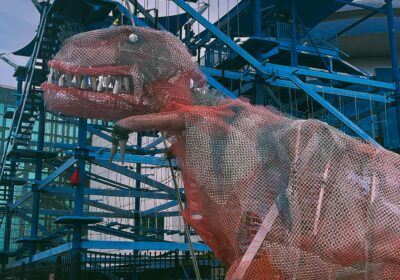Blood donation demand continues

The OneBlood Big Red Bus was parked outside of Cooper Hall on Tuesday. The bus can be found two to three days a week outside of Cooper, the Marshall Student Center and the Sun Dome.
ORACLE PHOTO/JACKIE BENITEZ
At about 1 p.m., the OneBlood Big Red Bus sitting in the field next to Cooper Hall let down its stairs, opening the way for donors to come in and give blood for Tuesday’s installment of the summer blood drive at USF.
The first donor of the day, Carey Whitehair, a senior majoring in mechanical engineering, said she hadn’t been able to give blood in a while, as she has just now gotten back on par with the 110-pound minimum weight requirement. Giving blood is something she tries to do regularly.
“It’s just the right thing to do,” Whitehair said. “It’ll barely cost me anything.”
Blood banks across the nation have seen spikes in donations in the aftermath of the Pulse nightclub shooting in Orlando. OneBlood spokesman Daniel Eberts said OneBlood, a nonprofit blood donation service, saw the number of blood donations more than double after the shooting, reaching more than 28,000 from the day of the shooting to the following Saturday.
There was also a 40 percent increase in first time donors and a large increase in O negative donors.
“For me, the silver lining in that cloud of violence was the humanity coming out, to give blood, to sponsor drives, to bring food to the donors and drinks, just people wanting to do something to help show compassion in the face of that tragedy,” Ebert said, adding that OneBlood also saw a 40 percent increase in first time donors.
However, the blood used to treat those in the immediate aftermath was not the blood donated Sunday. There is a 24-hour turnaround time for donated blood.
Instead, it was the blood on the shelf, donated before the tragedy occurred.
“When a trauma happens, you have a huge surge in blood needed immediately, which is why the blood that was on the shelf prior to the tragedy is what gave the initial lifeline to those injured people,” Eberts said.
The need for blood on the shelf goes beyond mass shootings like the one in Orlando. One blood serves most of the state of Florida as well as part of southern Alabama, South Carolina and southern Georgia.
At present, OneBlood needs at least 2,000 donations per day to meet the needs of patients at the more than 200 hospitals the organization serves.
“Sometimes it’s a struggle to keep up the blood supply,” Eberts said. “A safe and available blood supply is part of community health.”
The blood serves a variety of purposes, including helping those in surgery, people involved in accidents and those fighting disease. The portion of need devoted to people fighting disease is, according to Eberts, higher than the need for those in accidents and those in surgeries combined.
In this case, it went toward replenishing the inventory void left by the victims of the Pulse shooting.
In order to get the word out and collect blood, OneBlood uses its fleet of Big Red Buses, holds blood drives and operates donor centers throughout the region. Donors must weigh at least 110 lbs , be at least 16 years of age and in generally good health.
“When you become a blood donor, it’s part of your identity, part of the difference you can make,” Eberts said.
Sabaresh Krishnan, a sophomore in business, also donated blood on Tuesday’s visit in order to stay in good health and also help the victims of the Orlando shooting. He tries to donate at least twice a year to keep with longevity, donating old blood cells so that his body replaces them.
The need for certain types of blood, such as O negative and O positive is always high. However, the need for donated blood in general always remains.
“Every day it’s a real story, too,” Eberts said. “… Blood’s got to be there.”
The demand for blood that exists every day is part of why James Bell, a senior in education, makes a habit of donating blood. He said he knows the need for blood is immediate, and he himself has a rare blood type.
“You’ll never know when you’ll need (blood) too,” Bell said.
From May 17 to July 26, USF is hosting a blood drive, with all donors receiving a $10 Taco Bus gift card and a voucher for a free movie ticket.
OneBlood Donor Specialist Isabel Malave said the bus on campus sees about 15 to 20 donors per day, depending on the bus’s location. The bus shows up on campus two to three times a week, during the summer mostly on Tuesdays and Wednesdays. It circulates locations from Cooper Hall to the USF Sun Dome and the Marshall Student Center, the latter of which Malave said usually brings in the most donors.
This summer’s blood drive has brought in a good number of donors in Malave’s opinion.
“It’s been staying busy,” she said.







